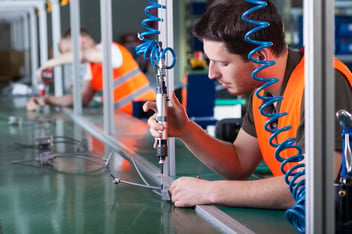How to Foster Student Engagement Through Local School Districts
Manufacturers have consistently faced the same issues over the past few years:
- Not enough applicants
- Not enough qualified candidates
- Open/unfilled positions
- Lack of talent constraining growth
Let’s take look at this issue through a different lens, though. If a piece of equipment consistently ran five to ten percent less output than necessary, fixing or replacing it would be a high-priority capital expenditure. Not only would engineers and technicians be assigned to find immediate solutions, the company’s best thinkers would be considering longer term investments to increase capacity to meet a two- to five-year projections.
Ok, so back to the talent pipeline. Let’s scrutinize that issue the same way as we do equipment. Rather than looking for immediate-impact levers, the focus could be on longer-term solutions, investing in a process that yields the volume of talent we need to grow over the next two to five years.
More than 8,000 high school students graduate each year in Cuyahoga County. Of that, about 3,000 will not head straight to college and another 3,000 will start but not finish higher ed.
The average Cuyahoga County student journeys through their entire K through 12 education without ever learning the career paths that manufacturing offers, without ever seeing a facility, without ever talking to someone about their work in manufacturing. Further, students don’t experience manufacturing by way of their day-to-day lives, the way they do retail and healthcare, for examples. The real nail in the coffin: students don’t have classes that simulate the skills or processes of manufacturing, which means they never get to find the spark for manufacturing we all found at some point.
We can grieve the loss of shop class (decades ago), but we can learn from the impact it had on many of our current employees who have been in industry for decades. Our local students to hear about manufacturing, talk to people that do the work and love it, see our facilities. We need to create that spark in young people that will pull them into our industry.
Here’s your simple (though not easy) call to action, manufacturers: Meaningfully engage with at least one K-12 education partner. This can support and foster in students manufacturing career discovery, exploration and interest-building.
The best schools work hard to find the right fit for each of their students, provide a wide range of opportunities that are right for their population and do what is necessary to unlock each student’s potential. If we can share the wide and compelling array of professional opportunities in manufacturing, which is significantly broader than most other industries, with education partners, we can put manufacturing front and center as a field of interest to graduating students. Manufacturing needs engineers the same way it need machinists, maintenance technicians and other skilled labor roles, and the same way it needs marketers, accountants, salespeople, supply chain and logistics professionals. People with all levels of math skills, all levels of professional ambition, all levels of leadership potential, could potentially find a path in manufacturing.
Clearly, not every young person will fall in love with manufacturing. But a huge win would be if just 10 to 15 percent of high school graduates left their K-12 experience focused passionately on a manufacturing career. The kicker: 10 to 15 percent is realistic, as that number tracks with the percentage of the Cuyahoga County population currently in manufacturing jobs.
Starting a relationship with a K-12 education partner requires a specific mindset: that you and the educator each have specific and necessary roles.
Manufacturers: Only you can speak to students with the passion and knowledge of what a typical day’s work entails; only you can offer the plant tours that will be the greatest hook. Further, only you can offer students shadowing or internship experiences, and teachers, guidance counselors and families the education and knowledge about the great opportunities in manufacturing so they overcome any of their apprehension about the industry.
To truly get the flywheel moving in a way that will help guide hundreds of students into manufacturing EVERY year going forward, manufacturers have to show the education ecosystem we are committed and excited about this work. Further, students will only deeply connect with, build a passion for and develop relationships in manufacturing by their experiences with you. Walking through a plant with you, seeing the movement, hearing the sounds and watching how the people interact with materials and machines will provide students the experience will be one of the most impactful and memorable moments in developing their manufacturing interest.
Educators/Schools: Schools own the relationships with the students and families—at least initially. Manufacturers must rely on those relationships and their trust from students to provide an entry-point to the conversation. Educators know how to fosters their students’ ambitions and skills, and how each student can fit with different manufacturing opportunities. Schools that will provide these opportunities most successfully to their students will approach the program as a very balanced relationship.
Tactically, here are the steps a manufacturer can take to engage with a school:
- Identify a local education partner(s) to engage.
- Geographic proximity simplifies logistics for your team and the students, and can prevent potential transportation issues for future employees
- Build a relationship.
- Invite students to your facility; go to their school and meet the key players; introduce them to people at all levels/functions in your business
- Craft effective and compelling experiences for the students with your education partner.
- Educators know how to engage the kids; you know manufacturing. Collaborative communication from both of you is necessary to be effective with students
- Integrate student experiences into your operations and staffing model.
- Identify and train staff for speaking opportunities, guiding student plant tours and supervising/mentoring interns
Keep your efforts simple and energy for the partnership high and committed, and the success will materialize. But should you need information and details about how best to present to students, set up a great plant tour, build a powerful internship experience and more, tap in to the manufacturing ecosystem’s resources, including the WorkforceConnect Manufacturing Sector Partnership. We have staff at both MAGNET and the Greater Cleveland Partnership deeply invested in and dedicated to this work, as we regularly visit classrooms to build awareness and an understanding of our industry to inspire students. We educate teachers and counselors to bolster their efforts, work with the administrators at local schools to design and implement systems and scaffolding for you to plug in when you’re ready. Our partners, like ManufacturingWorks, CollegeNow and Y.O.U., play specific roles that will continue to prioritize manufacturing as a top opportunity for students.
And once you overcome the hardest part – balancing the energy, patience and time necessary to launch this initiative well – the long-term capacity mentioned at the start of this post will manifest. Keep in mind this process is not meant to yield significant hires in the short term. Rather, this process focuses on building amazing success stories between you and students – yearly. You may also get the extra win of their friends and family as hires, as the students recommend working for your company.
As manufacturers, we aren’t always wired for long-term/yearly wins. We celebrate shipping product every day and bringing on new clients every week or month. But this initiative is meant to transform your organization over the span of years or a decade as our potential solution to the dearth of retirements looming. So we have to picture this work as a parallel path to that phenomenon over the next three to 10 years.
You will only get out of the student pipeline what you put into it, and it will take time to ramp up this machine’s output.




